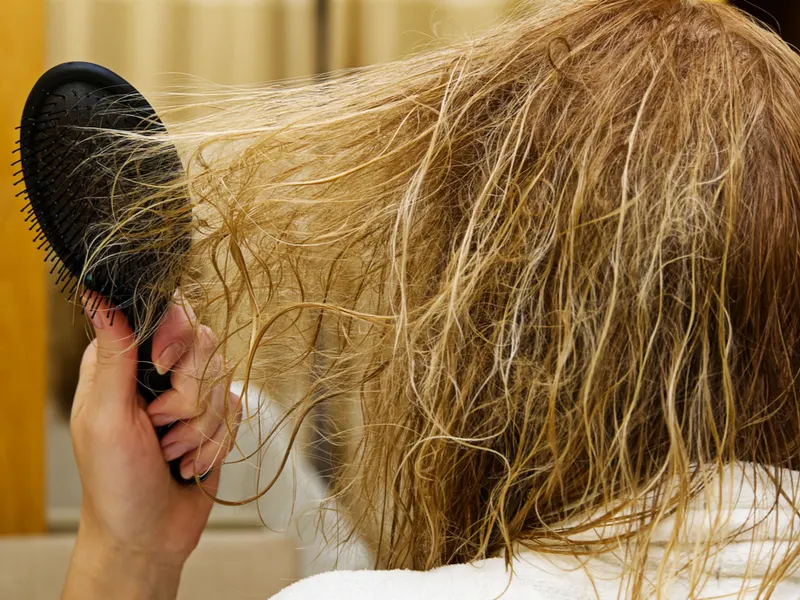Jump to:
All you wanted was a perm—just a change from your everyday hairstyle. Now you’re left wondering how to fix an over-processed perm. Whether it was a mix-up at the salon or a failed DIY kit, your hair is currently brittle and dry.
Luckily, we’ve got the step-by-step instructions to help you save your hair. Keep reading to learn more.
How to Fix an Over-Processed Perm in 8 Steps
When your hair is over-processed after a perm, it becomes extremely dry and brittle. According to a study by PeerJ, this is because of the chemicals used in perms. These chemicals change the molecular makeup of your hair.
When perm treatments stay on hair too long or interact poorly with treated hair, it results in over-processing.
To combat this damage, we’ve created an eight-step hair care guide. Check out these easy-to-follow steps to having healthy hair again.
1. Start Using Nourishing Shampoo and Conditioner
Choosing the right shampoo and conditioner is always important. However, when your hair has been damaged, it’s crucial. Additionally, the products you used before your perm may no longer be adequate.
Take the time to read the ingredients list on your shampoo. What you are looking for is nourishing ingredients. Here are a few of our favorites:
- Avocado
- Coconut oil
- Argan oil
- Shea butter
- Olive Oil
If your shampoo doesn’t have these ingredients, you will want to purchase a new one. Equally important, you want to make sure you’re not using products that include sulfates. Sulfates are a cleansing ingredient in shampoos.
However, according to Medical News Today, in their effort to clean your hair, they strip natural moisture and oils. This can be very damaging to already over-processed hair.
Read Next: What Oil Is Best for Hair?
2. Change Your Shampoo Routine
Once you’ve chosen a new set of products, it’s time to build a routine. You may have heard the advice to shampoo less often before. Using shampoo daily, even the super nourishing ones, can be counterproductive.
This is because the shampoo removes natural oils from your hair. This includes non-sulfate shampoos. While shampooing less is good for most people’s hair, it is necessary for damaged hair.
More if you can wait at least a day or two between washes. This will allow your hair’s natural oils to build back up and nourish your hair. Your new shampoo routine doesn’t stop at the products or the frequency. You also need to change the way you shampoo your hair.
Most of us have been taught to work shampoo through our hair from scalp to tip. This is detrimental to damaged hair. Massage shampoo into your scalp. Then rinse your shampoo out and let it wash through your hair.
Read Next: Take Our, “How Often Should I Shampoo My Hair” quiz!
3. Always Condition

Alliance Images/Shutterstock
Conditioner is your new best friend. Especially the first time you wash your hair after a perm. In this first wash, treat your conditioner like a hair mask. Leave it in for anywhere between 10-15 minutes to let it soak in.
You want to condition your hair every time you wash it. When conditioning, make sure to be gentle with your hair. Work it over every part of your hair, but with slow, gentle motions. Avoid tugging or twisting your hair.
You may use a comb to work conditioner through your hair. However, it should be done carefully to avoid stressing the worst of the damaged strands. Additionally, you don’t want to only condition on the days you wash.
Instead, look for leave-in conditioners that can be used daily. To use the conditioners, you will first get your hair slightly damp.
Then spray the conditioner over your hair and work it through gently with a comb. This is very beneficial not only for keeping your hair hydrated but also, to make detangling matted hair easier.
4. Implement Weekly Hair Masks
Hair masks can be an excellent option for damaged hair. A hair mask nourishes and hydrates your hair. They can also reduce frizziness, depending on the formula. As damaged hair is prone to being frizzy, this can help with styling.
Like with shampoo, take the time to read ingredients lists before buying a hair mask. Not all are created the same. Look for the same nourishing ingredients as before and use the mask as often as the directions allow.
Olive oil treatments are another regular way to care for your hair. These specialty treatments are designed to nourish hair and are often done only once a month. Olive oil treatments are more focused on your scalp than individual hair strands.
The treatment should be massaged into your scalp. This acts as a moisturizer, helping the new hair that grows to be at its most healthy. Olive oil treatments can be used in tandem with hair masks unless otherwise specified by the product’s instructions.
5. Air Dry Hair

Torwaistudio/Shutterstock
Blow-drying damaged hair is one of the worst things you can do to it. The heat further dehydrates your hair and can encourage breakage. Instead, you want to take the time to let your hair air dry. Do not use a regular towel on your hair.
When you step out of the shower, you want to gently pat your hair dry with a microfiber towel or t-shirt (also known as plopping hair). Regular towels can damage hair. They are also going to encourage your hair to become tangled.
Once your hair is no longer dripping wet, you can allow it to air dry naturally. If you are used to drying your hair in a special towel or turban, it’s essential to avoid this, at least at first.
These towels can put a strain on your hair if they are wound too tight and may lead to breakage. Some dryers will offer a cool-dry option. This can be used, but it is essential to be very gentle again. Move your hair carefully as you dry it, and try to avoid pulling or tugging at strands or tangles.
Additionally, if you must dry your hair with heat, some creams can be used to help protect your hair. These creams shield hair from the worst of the heat. They are also a great way to tame frizz.
6. Use Gentle Styling Techniques
So, this can be the most challenging part for people after a failed perm. You cannot heat style your hair. Any heat is going to be detrimental. In the worst-case scenario, it can result in hair falling out or burning.
This means no flat irons and no curling irons. Period.
While heat styling is the biggest ‘no-no’ for damaged hair, it’s not the only one. Like high-ponytails, cornrows, or braids, tight updos are also unsafe. The constant tension these styles put on your scalp and hair can cause it to break.
So, what about brushing? The most basic way to style hair? Well, even that has its caveats. You want to use a wire brush or comb on damaged hair. This helps on two fronts. One, it helps to prevent frizz. Thick-bristle brushes can increase static and frizz in hair.
Wire brushes and combs help to diffuse this effect. Secondly, these brushes allow you to have more control when working through hair. When brushing damaged hair, you want to work through knots carefully.
As mentioned before, tugging or pulling at hair is not good. Additionally, when using products, you want to choose with care. Some hair products will make it easier for your hair to tangle.
This doesn’t mean you can’t use any product on your hair. There are specially designed oils and serums that are great for styling hair and taming frizz. These ‘hair creams’ are a great way to give your hair shape and definition and not harm your hair.
7. Get Regular Trims
Trimming your hair regularly is a crucial aspect of caring for it. For damaged hair, this is how you remove the parts of the hair that cannot be healed. Make an appointment at least once a month to trim your hair and help to remove damaged ends slowly.
8. Let It Heal
We’ve covered several ways to care for hair. It’s essential not to overwork your hair when it is over-processed. However, the best thing you can do to your hair after washing and conditioning it properly is to leave it alone.
The more time your hair must strengthen and recover, the better it will look. This means moderating your expectations. Understand that your hair will take months and several trims to get back to ‘normal.’
No miracle product will undo damaged hair in a single wash or treatment. Don’t get frustrated or lose hope. Stick to a routine, and eventually, you will see results.
Frequently Asked Questions

VidEst/Shutterstock
Take a look at some popular questions regarding how to fix an over-processed perm:
Do all perms damage hair?
Not necessarily. A perm is a chemical treatment that changes the hair at the molecular level. According to Hair Professionals College, this chemical breaks down the keratin in your hair. This can weaken hair.
However, while this can be an intense process for your hair, it is not inherently damaging. In fact, perms tend to be less harmful than your average bleaching.
When can I dye my hair?
When a perm goes well, professionals suggest waiting two weeks before coloring. However, if a perm gets over-processed, you don’t want to add other chemicals to your hair for several months.
The main reason for this is that it will further damage your hair. The worst offender for this is box dyes. Box dyes often use harsh chemicals to prepare your hair to take color. These chemicals can be very damaging to already over-processed hair.
So, what about vegan or low-chemical hair coloring? Well, the process of adding color to hair can also be damaging. Because of this, it’s best to avoid coloring your hair until it is healthy enough to withstand the procedure.
What can make a perm go wrong?
Lots of things can go wrong whenever you are chemically treating hair. Perms, in particular, can be complicated and are best done by professionals.
Here’s a shortlist of the things that can go wrong:
- Chemicals can be mixed incorrectly
- The perm interacts poorly with other hair treatments (i.e., bleaching, box dyes)
- The chemicals get left on too long
So, How Do You Fix an Over-Processed Perm?
When your hair gets over-processed, the most important thing to remember is to treat it gently. Start with conditioning it thoroughly. Implement your new shampoo routine and treat your hair regularly with masks.
This will help strengthen your hair over time while reducing frizz. In the meantime, be careful with how you style your hair. Avoid heat and high-tension hairdos. You’ll have strong, healthy hair again before you know it by following our hair care guide.
